Japanese barberry Berberis thunbergii 'Kobold'

ABOUT
The Berberis thunbergii 'Kobold', commonly known as the Kobold Japanese Barberry, is a compact and dense shrub with a rounded shape. It features small, oval-shaped leaves that may have a rich, deep green color, which can turn into vibrant red or orange hues in the fall season, providing a striking display of autumn color. During the spring, this shrub produces tiny, inconspicuous yellow flowers that add a subtle touch of color to the plant's visual appeal. Following the flowering period, the Kobold Japanese Barberry may produce small, bright red berries that can attract birds and wildlife to the garden, while also offering a sharp contrast against the foliage. Its thorny stems give it a rugged, yet refined texture, serving both an aesthetic function in landscapes and a practical purpose as a defensive barrier. The plant's overall appearance is one that combines both ornamental beauty and hardy resilience, making it a popular choice for creating low hedges or as a stand-alone specimen in various garden settings.
About this plant
 Names
NamesFamily
Berberidaceae
Synonyms
Japanese Barberry, Thunberg's Barberry, Red Barberry
Common names
Berberis thunbergii 'Kobold'.
 Toxicity
ToxicityTo humans
Japanese Barberry is not generally considered highly toxic to humans; however, it may cause mild upset stomach if ingested. It's important to note that while not highly toxic, it can be potentially irritating due to the presence of alkaloids found in the leaves, stems, and roots. Ingesting large quantities could potentially lead to more serious symptoms, but typical casual contact or small accidental ingestion is not usually a cause for concern.
To pets
Japanese Barberry is similarly not highly toxic to pets, but it can cause gastrointestinal upset if ingested in significant amounts. If a pet consumes a large part of the plant, symptoms could include vomiting or diarrhea. While small amounts may not cause serious harm, it is always best to keep an eye on your pet and consult with a veterinarian if any signs of distress occur after ingestion.
 Characteristics
CharacteristicsLife cycle
Perennials
Foliage type
Deciduous
Color of leaves
Green
Flower color
Yellow
Height
2 feet (0.6 meters)
Spread
2 feet (0.6 meters)
Plant type
Shrub
Hardiness zones
4
Native area
Japan
Benefits
 General Benefits
General Benefits- Compact size: 'Kobold' is a dwarf cultivar, which makes it ideal for small gardens or limited spaces.
- Low maintenance: This plant requires minimal upkeep once established, making it a good choice for low-maintenance landscapes.
- Attractive foliage: Offers year-round visual interest with its reddish-purple leaves that can provide a striking contrast in the garden.
- Drought tolerance: Once established, it is quite drought-resistant, meaning it requires less watering compared to some other garden plants.
- Deer resistance: The plant has thorny stems and is generally unpalatable to deer, reducing the likelihood of deer damage in the garden.
- Seasonal interest: Features bright red berries in the fall and winter, and small yellow flowers in the spring, adding seasonal beauty to the landscape.
 Medical Properties
Medical Properties- This plant is not used for medical purposes.
 Air-purifying Qualities
Air-purifying QualitiesThis plant is not specifically known for air purifying qualities.
 Other Uses
Other Uses- Photography Prop: Berberis thunbergii 'Kobold', also known as Dwarf Japanese barberry, can be employed by photographers looking for a vibrant, compact shrub to complement outdoor portrait backgrounds.
- Soil Erosion Control: The compact growth habit of Dwarf Japanese barberry makes it useful for planting on slopes or areas prone to erosion, helping to stabilize soil with its root system.
- Natural Dyes: The bright red berries of the Dwarf Japanese barberry can be used to make natural dyes for fabrics or crafts, though care should be taken as they can be invasive.
- Winter Garden Interest: With its persistent red berries and textured, rust-colored bark, this shrub provides visual interest to otherwise bare winter gardens.
- Livestock Browsing Deterrent: When planted as part of a mixed barrier, the thorns of Dwarf Japanese barberry can help deter livestock from wandering or grazing in certain areas.
- Bonsai Specimen: Dwarf Japanese barberry's small size and naturally miniature leaves make it an interesting and less-common choice for bonsai enthusiasts.
- Wildlife Shelter: The dense foliage provides shelter for small birds and other wildlife, though the plant's invasive potential should be considered before planting for this purpose.
- Themed Gardens: This plant can be included in Asian-themed gardens, thanks to its origins and traditional use in Japanese garden design.
- Hedging for Miniature Landscapes: Dwarf Japanese barberry is suitable for creating low hedges in miniature or fairy-tale garden settings due to its compact growth.
- Study of Invasive Species: As an invasive species in many areas, Dwarf Japanese barberry can be used in educational settings to study the impact and management of such plants.
Interesting Facts
 Feng Shui
Feng ShuiThe Barberry is not used in Feng Shui practice.
 Zodiac Sign Compitability
Zodiac Sign CompitabilityThe Barberry is not used in astrology practice.
 Plant Symbolism
Plant Symbolism- Protection: Berberis thunbergii, commonly known as Japanese barberry, is often associated with protection because of its thorny branches, which can serve as a natural barrier against intruders, both physically and symbolically.
- Adaptability: The 'Kobold' variety, being a dwarf form, is known for its ability to adapt to various growing conditions, symbolizing flexibility and resilience in various environments.
- Sharpness: Japanese barberry's sharp thorns can represent a sharp intellect or wit, suggesting that the plant symbolizes mental acuity and the ability to protect one's thoughts and ideas.
 Water
WaterFor the Japanese Barberry 'Kobold', water the plant deeply once a week, ensuring the soil is moist but not waterlogged. During the hotter months, you may need to water more frequently, especially if there are prolonged periods without rain, increasing to twice per week. Each watering should provide enough water to soak the roots, using approximately 1 to 1.5 gallons per event, depending on the size of the plant and the environmental conditions. In the winter, reduce watering to every two to three weeks, or as needed, to prevent the soil from drying out completely. Always check the top few inches of soil for dryness before watering again.
 Light
LightJapanese Barberry 'Kobold' thrives in full sun to partial shade. It is best positioned in a spot where it can receive at least 6 hours of direct sunlight daily. This plant is adaptable, however, and can still do well in areas with light dappled shade, but its foliage color and flowering might not be as vibrant as when placed in full sun.
 Temperature
TemperatureJapanese Barberry 'Kobold' is quite hardy and can tolerate a range of temperatures; it performs best when the temperature is between 50°F and 70°F. It can survive in temperatures as low as -30°F, making it suitable for many temperate climates. Optimal growth and foliage color are often achieved within this ideal range, while extreme heat or cold may affect the plant's health.
 Pruning
PruningPrune the Japanese Barberry 'Kobold' to shape it, manage its size, or remove any dead or diseased branches. The best time to prune is late winter or early spring before new growth begins. Typically, pruning can be done annually, but it can also withstand more aggressive pruning every few years if needed to rejuvenate older plants.
 Cleaning
CleaningAs needed
 Soil
SoilJapanese Barberry 'Kobold' thrives best in well-draining soil enriched with organic matter, with a preferred soil pH ranging from slightly acidic to neutral (pH 5.5 to 7.5). A mix of garden soil, compost, and a bit of peat moss or perlite would make an ideal soil recipe.
 Repotting
RepottingJapanese Barberry 'Kobold' generally doesn't require frequent repotting and can be repotted every 3 to 5 years, or when it outgrows its current container.
 Humidity & Misting
Humidity & MistingJapanese Barberry 'Kobold' is tolerant of a wide range of humidity levels and does not have specific humidity requirements, making it adaptable to typical outdoor conditions.
 Suitable locations
Suitable locationsIndoor
Place in bright, indirect light and ensure pot has drainage.
Outdoor
Full sun to part shade, well-draining soil, protect from harsh winds.
Hardiness zone
4-8 USDA
 Life cycle
Life cycleJapanese barberry 'Kobold' begins its life as a seed, which germinates in spring under appropriate conditions of moisture and temperature. The seedling grows into a small shrub, developing a woody stem and a root system that anchor it into the soil. This perennial plant then enters a vegetative stage, where it produces a dense cluster of green leaves and may remain in this stage for several years. As the shrub matures, it begins to flower in the spring, with yellow flowers that are followed by bright red berries in the fall. These berries contain seeds, which can be dispersed by birds or other wildlife, allowing the plant to spread. After reaching maturity, Japanese barberry 'Kobold' can continue to live for many years, going through annual cycles of flowering and seeding, ensuring the survival of the species.
 Propogation
PropogationPropogation time
Late Summer to Fall
Propogation: The Japanese barberry 'Kobold' is commonly propagated through softwood cuttings, which is often regarded as the most popular method for this species. The best time for taking softwood cuttings is in late spring or early summer when new growth is mature enough to be semi-hard but still retains some flexibility. To propagate, one should select a healthy stem with new growth, cut a 4 to 6 inch (about 10 to 15 centimeters) section, remove the lower leaves, and dip the cut end into a rooting hormone powder to encourage root development. This prepared cutting should then be inserted into a moist potting mix containing equal parts peat and perlite, making sure to keep the humidity high and maintain a temperature of about 70 to 75 degrees Fahrenheit (approx. 21 to 24 degrees Celsius). Roots typically form within a few weeks, after which the new plants can be gradually acclimated to less humid conditions and eventually transplanted outdoors.
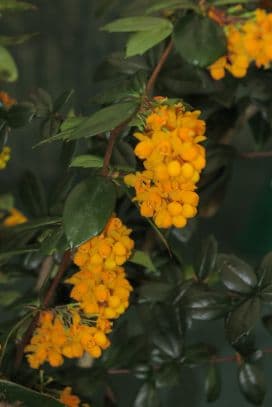
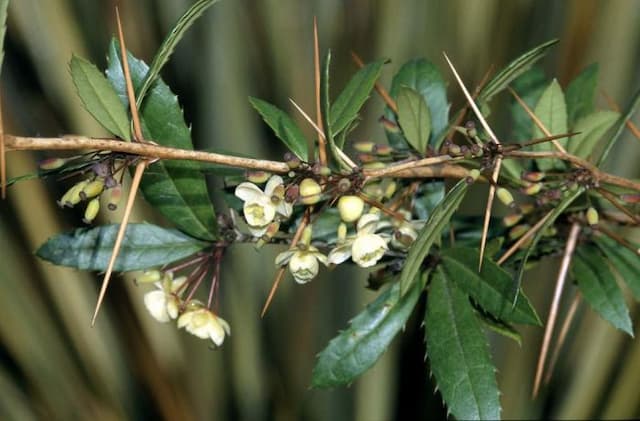
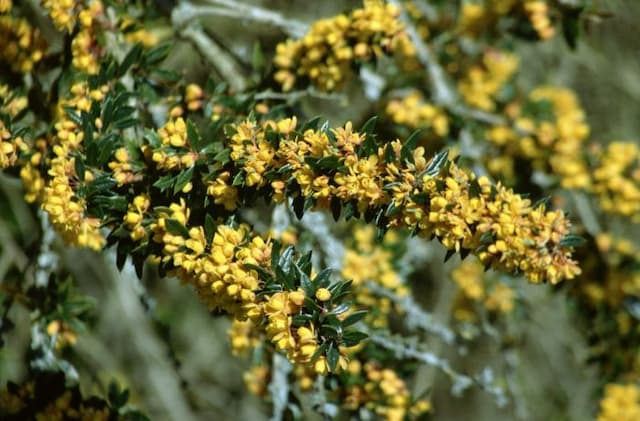
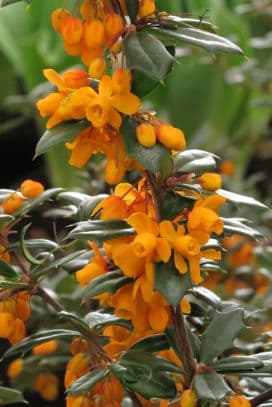
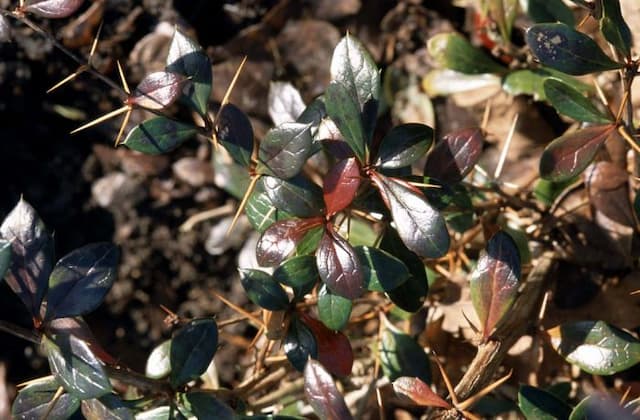


![Japanese barberry [Bonanza Gold]](/_next/image?url=https%3A%2F%2Fplants-admin.emdemapps.com%2Fimages%2Fplants%2F%2Fimages%2F604b5385e413f.png&w=640&q=75)

